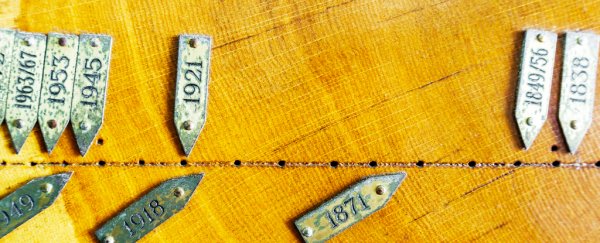One of the most important dating tools used in archaeology may sometimes give misleading data, new study shows - and it could change whole historical timelines as a result.
The discrepancy is due to significant fluctuations in the amount of carbon-14 in the atmosphere, and it could force scientists to rethink how they use ancient organic remains to measure the passing of time.
A comparison of radiocarbon ages across the Northern Hemisphere suggests we might have been a little too hasty in assuming how the isotope - also known as radiocarbon - diffuses, potentially shaking up controversial conversations on the timing of events in history.
By measuring the amount of carbon-14 in the annual growth rings of trees grown in southern Jordan, researchers have found some dating calculations on events in the Middle East – or, more accurately, the Levant – could be out by nearly 20 years.
That may not seem like a huge deal, but in situations where a decade or two of discrepancy counts, radiocarbon dating could be misrepresenting important details.
The science behind the dating method is fairly straightforward: nitrogen atoms in the atmosphere hit with cosmic radiation are converted into a type of carbon with eight neutrons. This carbon – which has an atomic mass of 14 – has a chance of losing that neutron to turn into a garden variety carbon isotope over a predictable amount of time.
By comparing the two categories of carbon in organic remains, archaeologists can judge how recently the organism that left them last absorbed carbon-14 out of its environment.
Over millennia the level of carbon-14 in the atmosphere changes, meaning measurements need to be calibrated against a chart that takes the atmospheric concentration into account, such as INTCAL13.
The current version of INTCAL13 is based on historical data from North America and Europe, and has a fairly broad resolution over thousands of years. Levels do happen to spike on a local and seasonal basis with changes in the carbon cycle, but carbon-14 is presumed to diffuse fast enough to ignore these tiny bumps.
At least, that was the assumption until now.
"We know from atmospheric measurements over the last 50 years that radiocarbon levels vary through the year, and we also know that plants typically grow at different times in different parts of the Northern Hemisphere," says archaeologist Sturt Manning from Cornell University.
"So we wondered whether the radiocarbon levels relevant to dating organic material might also vary for different areas and whether this might affect archaeological dating."
The tree rings were samples of Jordanian juniper that grew in the southern region of the Middle East between 1610 and 1940 CE. By counting the tree rings, the team were able to create a reasonably accurate timeline of annual changes in carbon-14 uptake for those centuries.
Alarmingly, going by INTCAL13 alone, those same radiocarbon measurements would have provided dates that were older by an average of 19 years.
The difference most likely comes down to changes in regional climates, such as warming conditions. Extrapolating the findings back to earlier periods, archaeologists attempting to pinpoint Iron Age or Biblical events down to a few years would no doubt have a serious need to question their calibrations.
One controversial example is the dating of a single layer of archaeology at the Bronze and Iron Age city buried at Tel Rehov.
Just a few decades of difference could help resolve an ongoing debate over the extent of Solomon's biblical kingdom, making findings like these more than a minor quibble in a politically contested part of the world.
"Our work indicates that it's arguable their fundamental basis is faulty – they are using a calibration curve that is not accurate for this region," says Manning.
Collecting additional data from different geographical areas and taking a closer look at historical climate trends could help sharpen calibration techniques, especially in hotly debated regions.
For the time being, archaeologists covering history in the Levant are being advised to take their dates with a pinch of salt.
This research was published in the Proceedings of the National Academy of Sciences.
